Where to dig in?
Creating a welcoming outdoor space doesn’t require complex landscaping. Start with drought-tolerant plants like sedums or native options that need minimal care. Add budget-friendly features by repurposing everyday items into planters or decorations. In small spaces, grow vertically with wall-mounted containers or trellises. Consider adding a simple water feature, such as a bubbling urn, for tranquility. Finish with basic hardscaping elements like stone pathways or garden edging that provide structure without overwhelming maintenance. These foundational elements set the stage for your personal outdoor sanctuary.
Easy Plant Choices for Low-Maintenance Yards
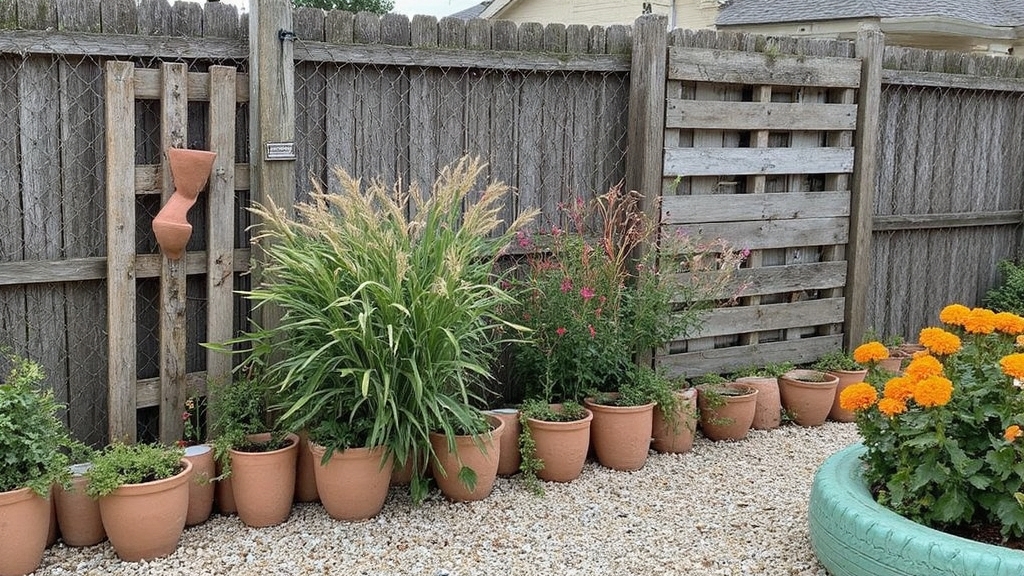
When planning a low-maintenance landscape, selecting the right plants is essential for success. Focus on drought-tolerant options like Sedum and Liriope that store water efficiently and require minimal care once established. Hardy perennials, including Daylilies, Black-Eyed Susans, and Coneflowers, offer beautiful blooms with little attention needed.
Consider replacing traditional grass with alternatives such as Creeping Thyme or Clover, which need less water and mowing. Native plants like Butterfly Milkweed and Bee Balm aren’t just easy to maintain, they’ll also attract beneficial wildlife to your garden. For a stylish, organized look with reduced upkeep, incorporate minimalist garden designs that emphasize clean lines and neutral color palettes. For indoor-outdoor transitions, consider adding snake plants or ZZ plants that thrive with minimal attention while adding architectural interest to patios and entryways.
For structure and year-round interest, incorporate low-maintenance trees and shrubs such as Boxwoods, Hydrangeas, or Arborvitae. These woody plants require minimal pruning while providing reliable foundation elements for your simplified landscape design.
Ideas for Simple Landscaping: Budget-Friendly Garden Features
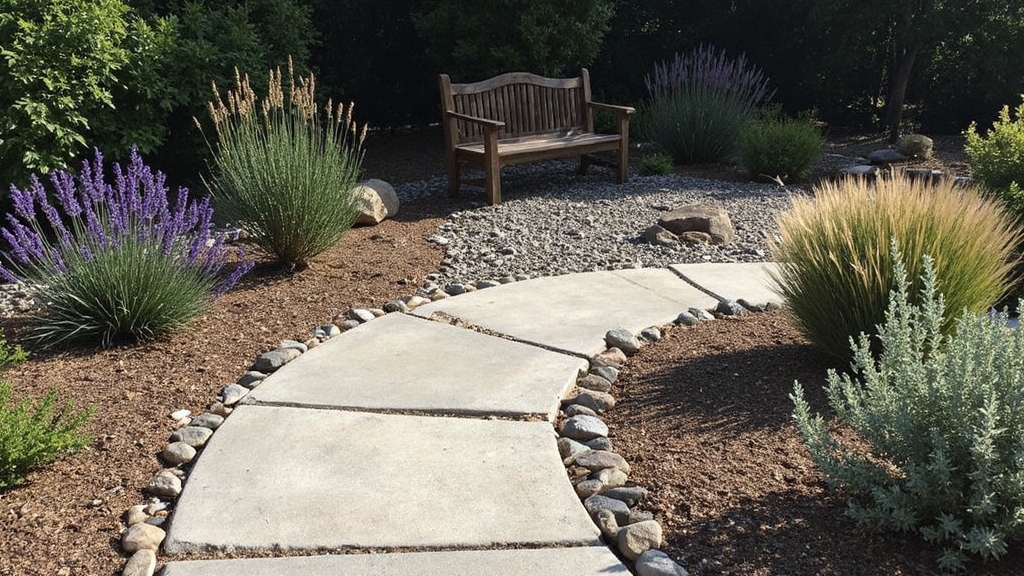
Transforming your outdoor space doesn’t have to drain your wallet, as many stunning garden features can be created with minimal investment. Consider these affordable approaches:
Beautiful gardens don’t require big budgets—just creativity, repurposed materials, and a little gardening know-how.
- Repurpose Everyday Items: Turn old wheelbarrows into colorful planters by drilling drainage holes, or transform wooden pallets into vertical gardens.
- Use Natural Materials: Incorporate branches, stones, and fallen logs to create decorative borders and pathways at zero cost. Chopped autumn leaves make an excellent, free organic mulch for garden beds while adding a natural aesthetic to your landscape.
- DIY Structures: Build arched trellises for climbing vines or raised beds from reclaimed wood to add dimension without expense. Creating functional zones in your backyard can maximize usability while maintaining a cohesive design.
- Strategic Planting: Divide existing perennials like geraniums and geums to multiply your plants for free.
- Thrifty Decorations: Hang mirrors to create illusion of space, and install solar lights for evening ambiance without increasing your electricity bill.
Vertical Solutions for Small Outdoor Spaces

Limited outdoor space doesn’t mean limited gardening possibilities, especially if you’re willing to think upward instead of outward. Vertical gardening maximizes your available area while creating visual interest in compact spaces.
Try these space-efficient approaches:
- Mount containers on walls or fences for herbs and succulents
- Install a green wall using specialized planters or pocket systems
- Set up trellises for climbing vegetables or flowering vines
- Hang baskets from overhead structures for trailing plants
- Repurpose wooden pallets into vertical planters
For sustainability, collect rainwater to irrigate your vertical garden, and choose drought-tolerant plants that need less maintenance. Use a lightweight soil mix containing perlite and vermiculite in your vertical containers to prevent compaction and improve drainage. Get creative with upcycled materials like old ladders or bookshelves to create unique garden structures that won’t break your budget. Shoe organizers offer a practical solution as they can be transformed into a vertical garden system by adding drainage holes at the bottom of each pocket.
Water Elements That Enhance Tranquility

Three key water features can transform your outdoor space into a peaceful retreat, creating a sensory experience that soothes both mind and body. Wall fountains work perfectly in tight spaces, providing vertical interest while masking traffic noise with their gentle cascades. For minimal maintenance, consider pondless waterfalls that deliver soothing sounds without the upkeep of a full pond.
Bubbling urns offer compact solutions for patios, combining visual movement with stress-reducing auditory benefits. The therapeutic effects of water features can encourage individuals to prop their feet up and unwind after a busy day. Having a quality garden hose option nearby makes maintaining these water features much easier and more efficient.
Water features do more than please the eye—they cool surrounding areas, increase humidity, and attract beneficial wildlife. You’ll notice improved concentration as the white noise effect blocks distractions, potentially lowering your blood pressure through stress reduction. Position these elements where they’ll reflect natural light, amplifying your garden’s colors and creating an engaging focal point.
Hardscaping Basics for Structure and Appeal
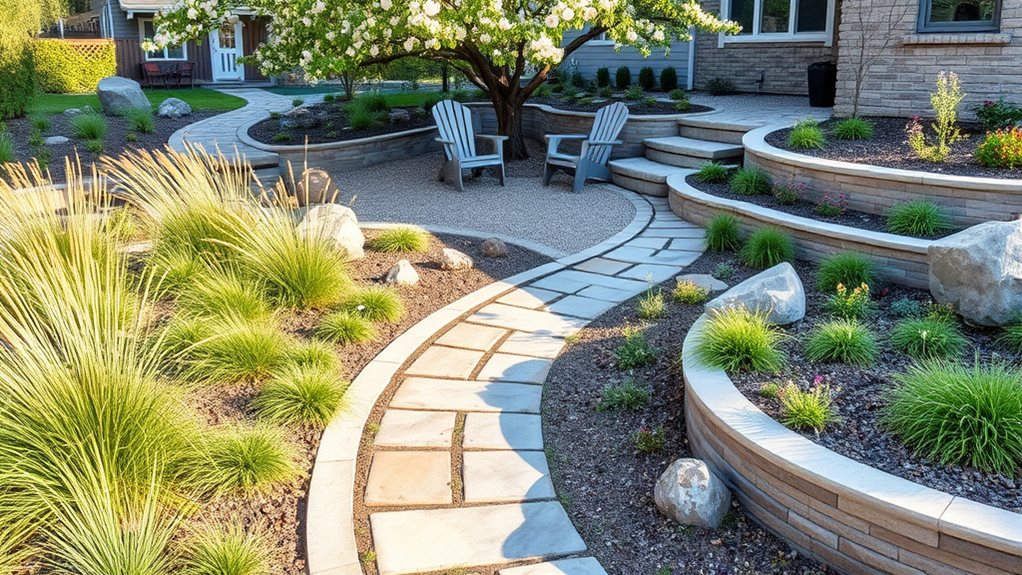
Strong, well-designed hardscaping creates the backbone of any landscape, providing structure that complements your garden’s softer elements. When planning your outdoor space, consider how patios, walkways, and retaining walls can define areas while adding visual interest. Strategically placed water features can add both visual appeal and practical functionality to your outdoor design. For inspiration, visit renowned spaces like Longwood Gardens in Pennsylvania, where hardscaping elements frame over 1,077 acres of diverse botanical displays.
| Material | Best Uses | Maintenance Level |
|---|---|---|
| Stone | Pathways, walls | Low |
| Brick | Patios, edging | Medium |
| Concrete | Driveways, patios | Low |
| Wood | Decking, fences | High |
Choose materials that harmonize with your home’s architecture and the surrounding environment. Remember, hardscaping isn’t just functional—it adds value to your property and reduces overall maintenance. For beginners, start with simple projects like garden edging or a gravel path, then gradually tackle larger elements as your confidence grows.
Outdoor Living Areas for Gathering and Relaxation
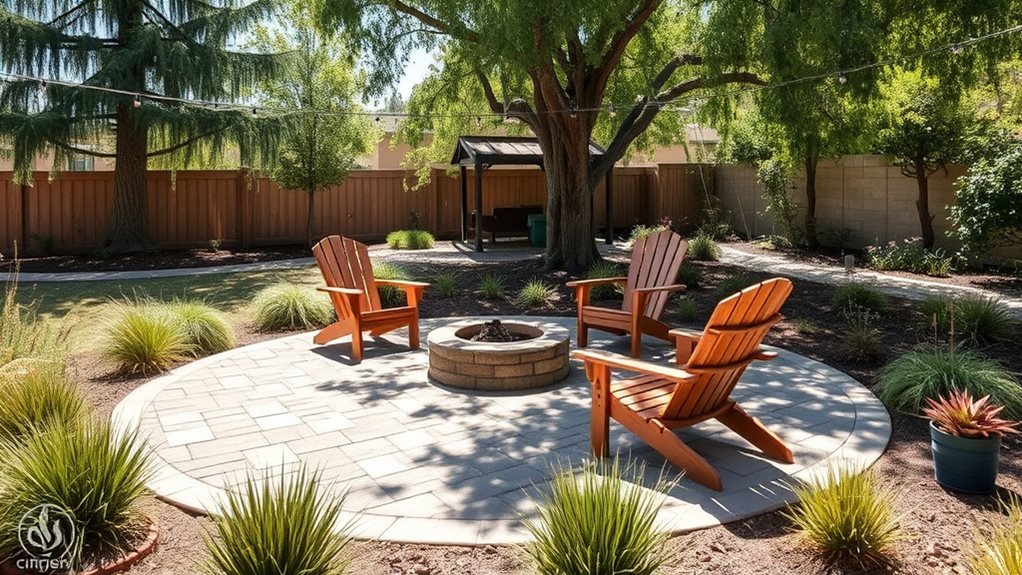
Creating inviting outdoor living areas has become a cornerstone of modern home design, with covered patios leading the way. Nearly 44% of experts cite covered patios as the most popular choice, and they’re proven to boost your home’s value greatly. You’ll want to focus on making your outdoor space feel like a natural extension of your indoor living areas. This trend aligns with homeowners’ growing preference, as patio popularity continues to increase with 63.7% of new homes including this feature by 2023. Consider using garden planning apps to help visualize your outdoor living space before implementation, making it easier to arrange elements effectively.
Today’s homeowners are embracing the seamless transition from indoor comfort to outdoor luxury, elevating property value while enhancing daily living.
For the best results, consider these key elements:
- Smooth integration – Match your indoor and outdoor flooring for a cohesive look that draws people outside
- Functional zones – Dedicate areas for cooking, dining, and relaxing to maximize usability
- Weather protection – Invest in coverage that allows year-round enjoyment, regardless of sun or rain
Your outdoor living space should balance comfort with practicality, using durable, low-maintenance materials that suit your regional climate.
Lighting Strategies to Showcase Your Landscape
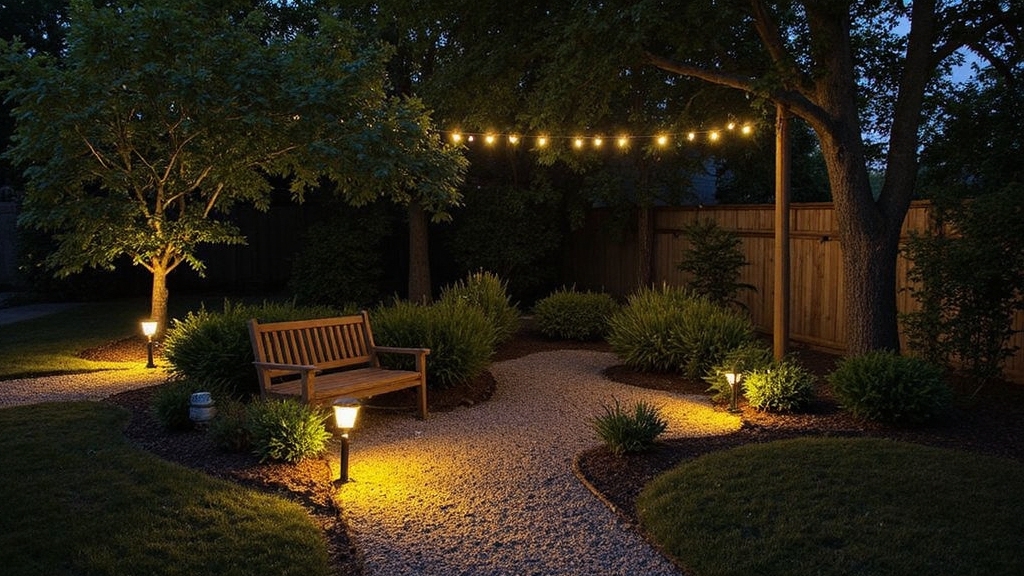
While daylight reveals your garden’s beauty, thoughtful landscape lighting transforms your outdoor space into a magical nighttime retreat. Incorporate these simple techniques to highlight your landscape’s best features:
- Uplighting: Position lights at the base of trees or structures, using narrow beams (10°-30°) for trunks and wider beams (45°-60°) for foliage.
- Moonlighting: Mount fixtures high in trees facing downward to create natural-looking shadows on paths below.
- Silhouetting: Place lights behind distinctive plants to create dramatic outlines against walls or surfaces.
- Path Lighting: Space fixtures 6-10 feet apart at 12-24 inches tall to facilitate safe navigation without glare. Consider using in-ground lights for unique pathway effects that appear to emerge naturally from the landscape. For watering your illuminated garden areas, a kink-resistant hose like the Flexzilla can make nighttime maintenance more manageable.
- Layered Approach: Combine different lighting types at varying heights for depth, and consider dimmers to adjust the mood for different occasions.
Sustainable Practices for Eco-Friendly Yards

How can your landscape benefit both your property and the planet? Creating an eco-friendly yard isn’t just good for the environment—it saves you time and money while creating a beautiful outdoor space. You’ll reduce water bills, minimize maintenance, and support local wildlife with just a few simple changes. Utilizing performance metrics can help quantify these benefits and provide evidence for making sustainable landscaping decisions. Consider implementing no-till techniques that preserve soil structure and enhance microbial activity without disrupting your garden beds.
Try these eco-friendly approaches:
- Plant native species that naturally thrive in your region, requiring less water and fewer pesticides while providing habitat for local pollinators.
- Install smart irrigation systems or drip hoses that deliver water directly to roots, cutting water usage by up to 50% compared to traditional sprinklers.
- Switch to organic soil management by composting yard waste and applying mulch, which retains moisture, suppresses weeds, and enriches soil naturally.
Frequently Asked Questions
How Do I Keep Pests Away Without Harming Beneficial Insects?
You’ll preserve beneficial insects while deterring pests by using physical barriers like deer fences and insect screens.
Plant companion flowers such as fern-leaf yarrow and marigolds, which attract helpful predators. Apply targeted treatments like diatomaceous earth for soft-bodied pests, and use B.T. for specific caterpillar control.
Monitor plants daily, remove debris regularly, and focus on building plant health through crop rotation and composting. These approaches create balance in your garden without harming your pollinator allies.
What’s the Best Landscaping Approach for Rental Properties?
For rental properties, focus on a low-maintenance approach that balances curb appeal with practicality. You’ll want to:
- Minimize lawn areas with drought-resistant ground covers
- Install native plants that thrive with minimal care
- Use mulch extensively to reduce weeding and water needs
- Incorporate simple hardscaping like gravel paths or patios
- Create clear maintenance guidelines for tenants
This combination keeps your property attractive while reducing ongoing costs and tenant frustration with complicated upkeep requirements.
How Can I Create Privacy From Neighbors Without Tall Fences?
You can create effective privacy without tall fencing by:
- Planting columnar trees like Italian cypress in tight rows along boundaries
- Installing bamboo screens or artificial greenery panels that provide instant coverage
- Using hanging planters and vertical gardens to soften exposed areas
- Setting up water features that mask neighborhood noise
- Creating layered plantings with evergreens in back and flowering shrubs in front
These solutions work well in rental properties since they’re often movable or temporary.
When Is the Ideal Time to Renovate My Existing Landscape?
Plan your landscape renovation during winter to secure contractors and permits. You’ll want to install plants in spring or fall when temperatures are moderate, helping roots establish before seasonal extremes.
Consider your specific projects carefully—seed cool-season grass in fall, plant perennials in spring, and schedule hardscaping during dry periods. Match your timeline to your regional climate patterns, particularly frost dates.
How Do Seasonal Weather Changes Affect My Landscaping Choices?
Your landscaping choices should adapt to each season’s conditions. In spring, focus on planting flowers that thrive in mild temperatures and preparing soil after winter.
Summer demands drought-resistant plants and proper irrigation systems to combat heat. Fall requires plants that showcase autumn colors, while winter calls for hardy evergreens that withstand frost. Always consider your region’s specific climate patterns, as local weather variations directly impact which plants will flourish in your outdoor space.
Conclusion
You’ve now discovered multiple ways to transform your outdoor space without breaking the bank or requiring professional expertise. Start with just one or two of these simple ideas, and watch how your yard evolves into a personal sanctuary. Remember, the best landscapes develop over time, reflecting your personal style and needs. With these accessible techniques, you’ll create an outdoor space that welcomes both family and visitors for years to come.

